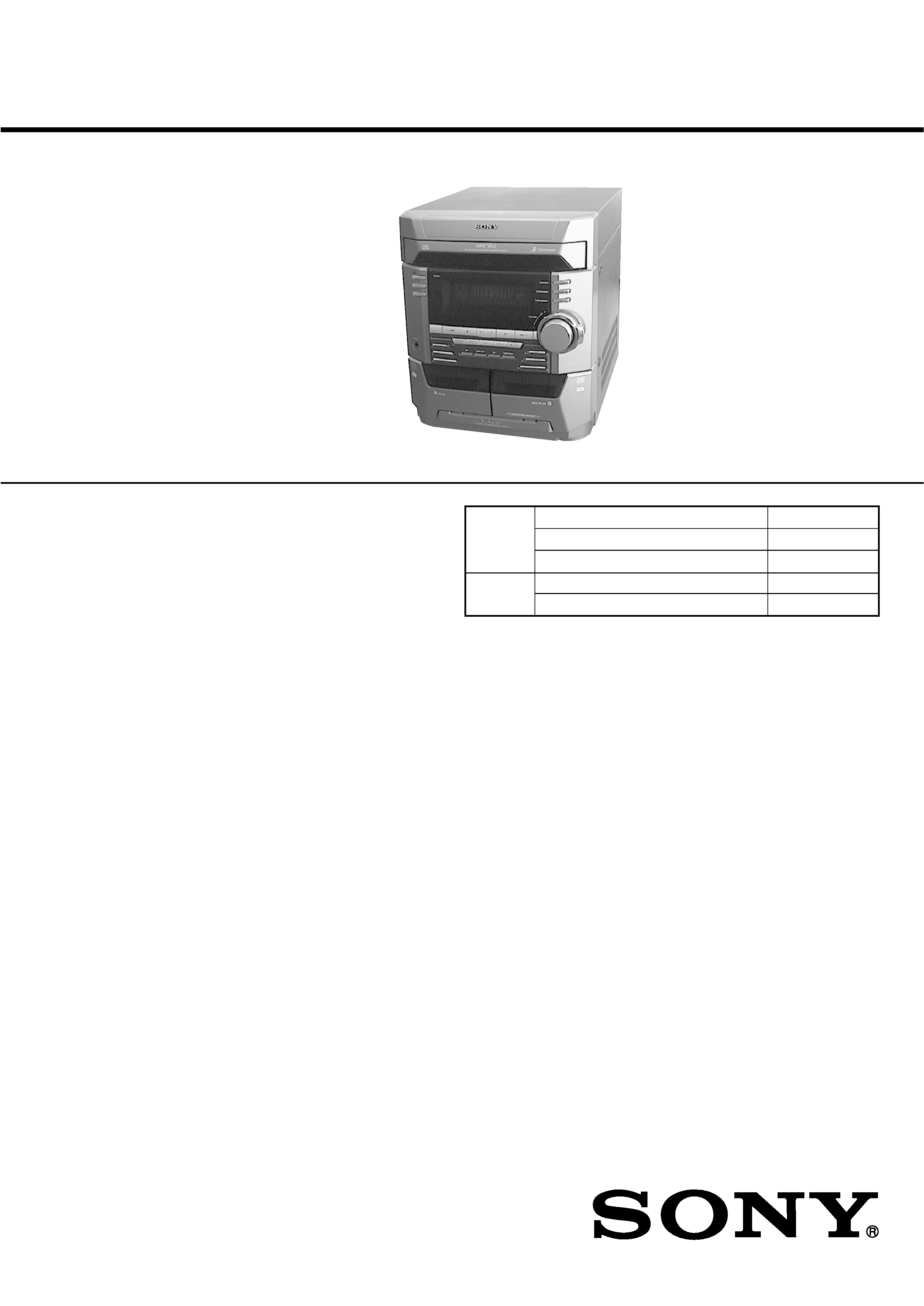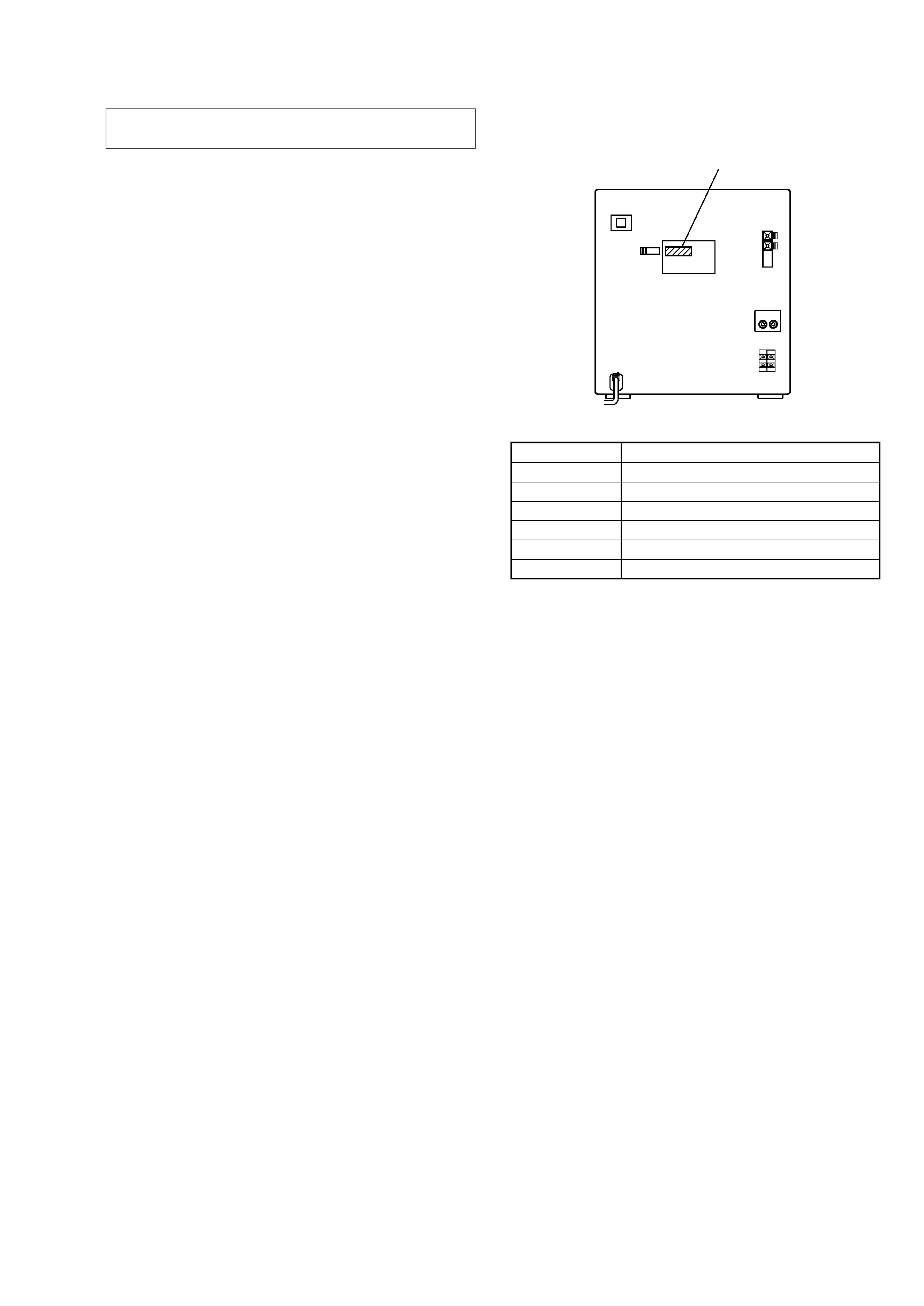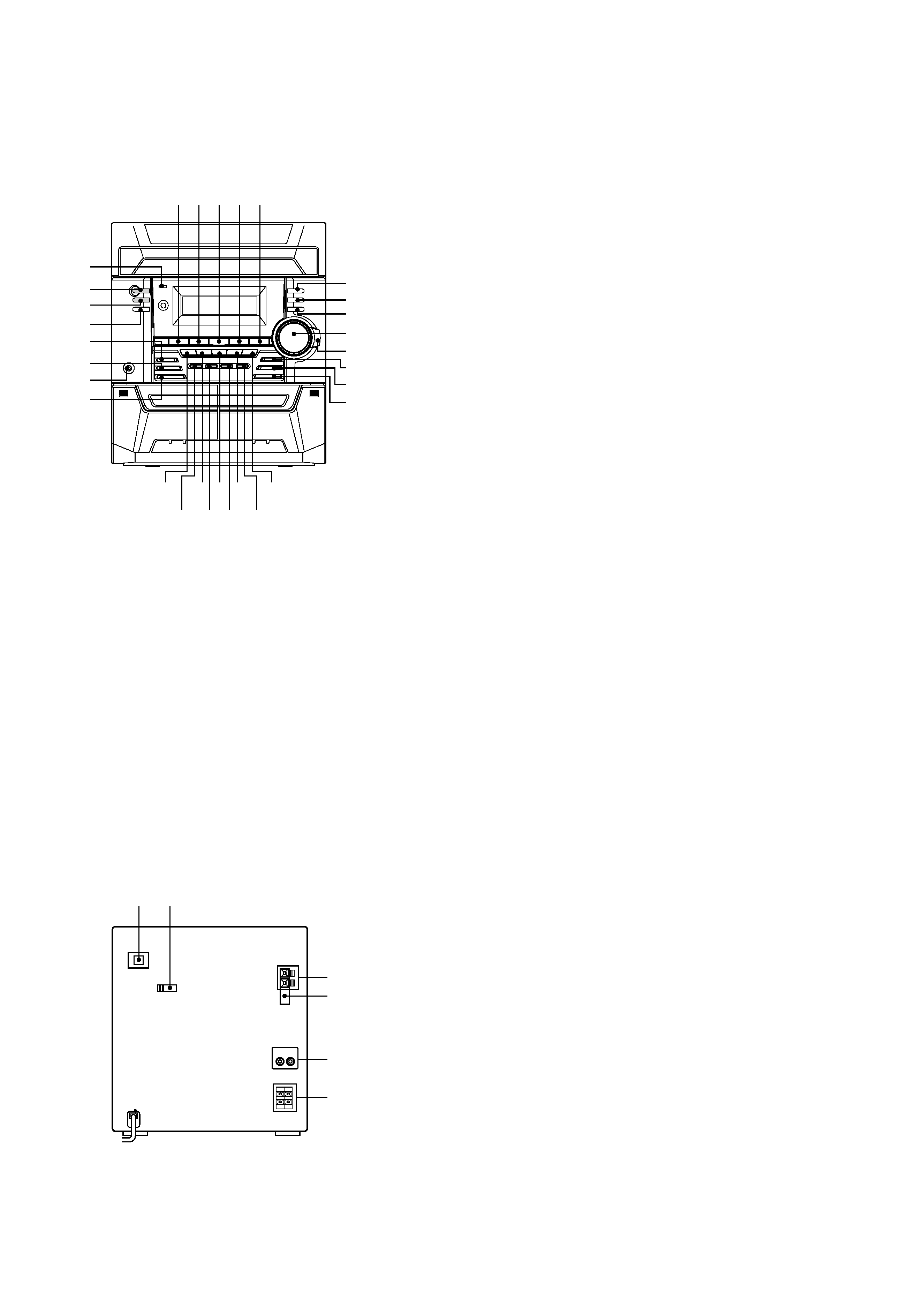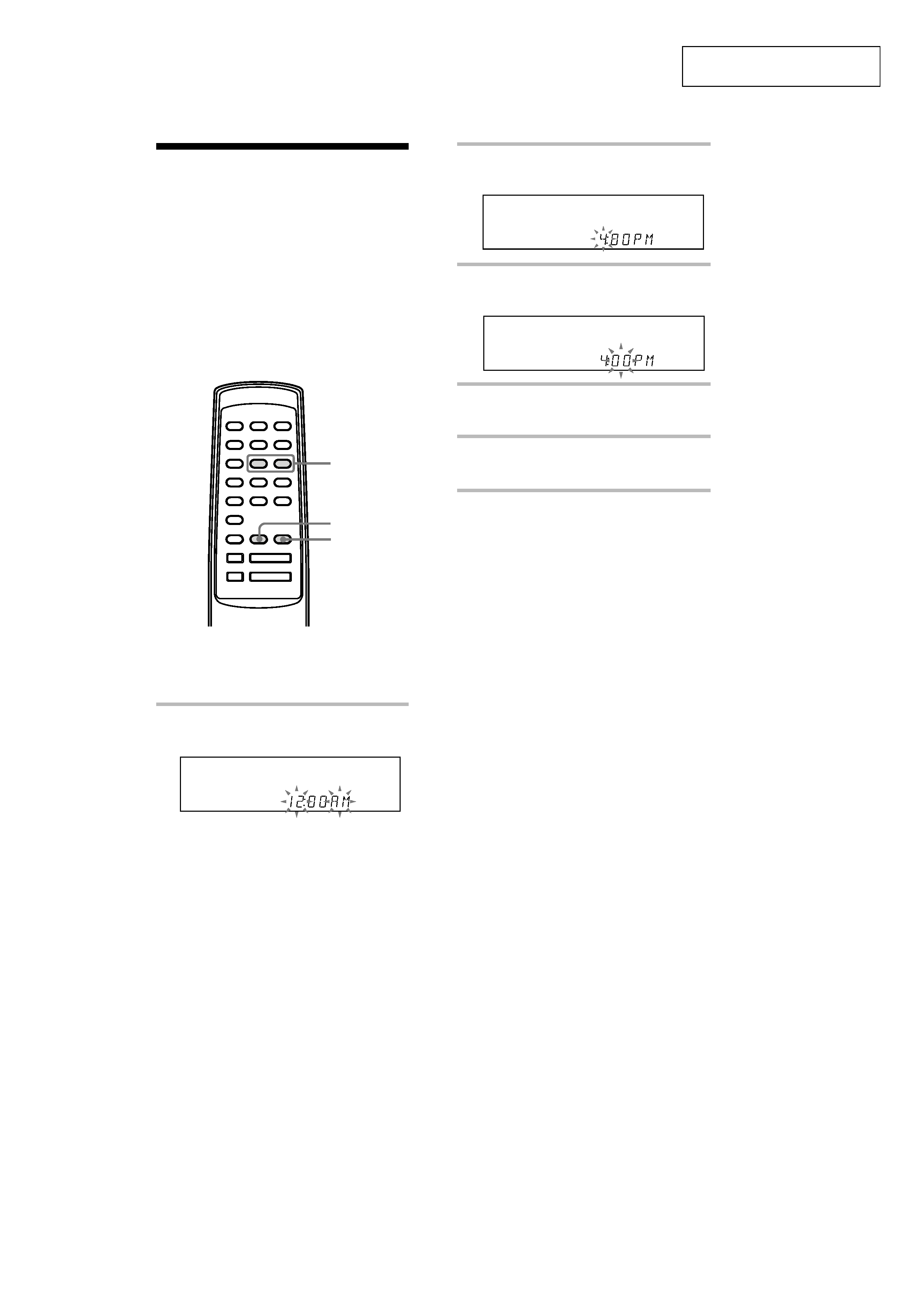
SERVICE MANUAL
MINI HiFi COMPONENT SYSTEM
US Model
Canadian Model
AEP Model
UK Model
HCD-BX2
E Model
HCD-DX2/DX2B
Australian Model
HCD-DX2
SPECIFICATIONS
HCD-BX2/DX2/DX2B
HCD-BX2/DX2/DX2B is the Amplifier,
CD player, Tape Deck and Tuner
section in HMC-BX2/DX2/DX2B.
Photo: HCD-BX2
Dolby noise reduction manufactured under license
from Dolby Laboratories Licensing Corporation.
"DOLBY" and the double-D symbol ; are trade-
marks of Dolby Laboratories Licensing Corporation.
Model Name Using Similar Mechanism
NEW
CD Mechanism Type
EXL-M7
Optical Pick-up Name
OPTIMA-7
Model Name Using Similar Mechanism
HCD-GRX20
Tape Transport Mechanism Type
CWL-44-FR
CD
Section
Tape deck
Section
AUDIO POWER SPECIFICATIONS:
(U.S.A. model only)
POWER OUTPUT AND TOTAL
HARMONIC DISTORTION:
with 6 ohm loads both channels driven, from
120 10,000 Hz; rated 60 watts per channel
minimum RMS power, with no more than
10% total harmonic distortion from
250 milliwatts to rated output.
Amplifier section
Canadian model:
Continuous RMS power output
50 + 50 watts
(6 ohms at 1 kHz,
10% THD)
European model:
DIN power output (Rated)
40 + 40 watts
(6 ohms at 1 kHz, DIN)
Continuous RMS power output (Reference)
50 + 50 watts
(6 ohms at 1 kHz,
10% THD)
Music power output (Reference)
100 + 100 watts
(6 ohms at 1 kHz,
10% THD)
Other models:
The following measured at AC 110, 220 V 60 Hz:
DIN power output (Rated)
45 + 45 watts
(6 ohms at 1 kHz, DIN)
Continuous RMS power output (Reference)
50 + 50 watts
(6 ohms at 1 kHz,
10% THD)
The following measured at AC 120, 240 V 60 Hz:
DIN power output (Rated)
50 + 50 watts
(6 ohms at 1 kHz, DIN)
Continuous RMS power output (Reference)
60 + 60 watts
(6 ohms at 1 kHz,
10% THD)
Inputs
MD IN:
voltage 450 mV,
(phono jacks)
impedance 47 kilohms
Outputs
PHONES:
accepts headphones of
(stereo mini jack)
8 ohms or more
SPEAKER:
HCD-BX2:
accepts impedance of 6 to
16 ohms
HCD-DX2:
accepts impedance of 6 to
16 ohms
CD player section
System
Compact disc and digital
audio system
Laser
Semiconductor laser
(
=780nm)
Emission duration:
continuous
Laser output
Max. 44.6
µW*
*This output is the value
measured at a distance of
200 mm from the
objective lens surface on
the Optical Pick-up Block
with 7 mm aperture.
Wavelength
780 790 nm
Frequency response
20 Hz 20 kHz (±0.5 dB)
Signal-to-noise ratio
More than 90 dB
Dynamic range
More than 90 dB
CD OPTICAL DIGITAL OUT
(Square optical connector jack, rear panel)
Wavelength
660 nm
Output Level
18 dBm
Tape player section
Recording system
4-track 2-channel stereo
Frequency response
40 13,000 Hz (±3 dB),
using Sony TYPE I
cassette
Tuner section
FM stereo, FM/AM superheterodyne tuner
FM tuner section
Tuning range
87.5 108.0 MHz
Antenna
FM lead antenna
Antenna terminals
75 ohm unbalanced
Intermediate frequency
10.7 MHz
AM tuner section
Tuning range
Pan-American model:
530 1,710 kHz
(with the interval set at
10 kHz)
531 1,710 kHz
(with the interval set at
9 kHz)
European and Middle Eastern models:
531 1,602 kHz
(with the interval set at
9 kHz)
Other models:
531 1,602 kHz
(with the interval set at
9 kHz)
530 1,710 kHz
(with the interval set at
10 kHz)
Antenna
AM loop antenna
Antenna terminals
External antenna terminal
Intermediate frequency
450 kHz
Continued on next page
Ver 1.1 2001.02
With SUPPLEMENT-1
(9-929-070-81)
9-929-070-12
Sony Corporation
2001B0500-1
Audio Entertainment Group
C
2001.2
General Engineering Dept.

2
ATTENTION AU COMPOSANT AYANT RAPPORT
À LA SÉCURITÉ!
LES COMPOSANTS IDENTIFIÉS PAR UNE MARQUE 0
SUR LES DIAGRAMMES SCHÉMATIQUES ET LA LISTE
DES PIÈCES SONT CRITIQUES POUR LA SÉCURITÉ
DE FONCTIONNEMENT. NE REMPLACER CES COM-
POSANTS QUE PAR DES PIÈCES SONY DONT LES
NUMÉROS SONT DONNÉS DANS CE MANUEL OU
DANS LES SUPPLÉMENTS PUBLIÉS PAR SONY.
SAFETY-RELATED COMPONENT WARNING!!
COMPONENTS IDENTIFIED BY MARK 0 OR DOTTED
LINE WITH MARK 0 ON THE SCHEMATIC DIAGRAMS
AND IN THE PARTS LIST ARE CRITICAL TO SAFE
OPERATION. REPLACE THESE COMPONENTS WITH
SONY PARTS WHOSE PART NUMBERS APPEAR AS
SHOWN IN THIS MANUAL OR IN SUPPLEMENTS PUB-
LISHED BY SONY.
TABLE OF CONTENTS
1.
SERVICING NOTES ............................................... 3
2.
GENERAL
Location of Controls .......................................................
4
Setting the Time ..............................................................
5
3.
DISASSEMBLY ......................................................... 6
4.
DIAGRAMS
4-1. Note for Printed Wiring Boards and
Schematic Diagrams ....................................................... 13
4-2. Schematic Diagram CD Section (1/4) ..................... 14
4-3. Schematic Diagram CD Section (2/4) ..................... 15
4-4. Schematic Diagram CD Section (3/4) ..................... 16
4-5. Schematic Diagram CD Section (4/4) ..................... 17
4-6. Printed Wiring Boards CD Section ......................... 18
4-7. Printed Wiring Boards MAIN/TR Boards ............... 19
4-8. Schematic Diagram MAIN Board (1/4) .................. 20
4-9. Schematic Diagram MAIN Board (2/4) .................. 21
4-10. Schematic Diagram MAIN Board (3/4) .................. 22
4-11. Schematic Diagram
MAIN (4/4)/TR Boards ............................................ 23
4-12. Schematic Diagram PANEL Section (1/3) .............. 24
4-13. Schematic Diagram PANEL Section (2/3) .............. 25
4-14. Schematic Diagram PANEL Section (3/3) .............. 26
4-15. Printed Wiring Board PANEL Section .................... 27
4-16. Printed Wiring Board AMP Board
(US, Canadian, AEP, UK, Australian models) ............ 28
4-17. Schematic Diagram AMP Board
(US, Canadian, AEP, UK, Australian models) ............ 29
4-18. Printed Wiring Boards
AMP (E model)/AC/FUSE Boards ........................... 30
4-19. Schematic Diagram
AMP (E model)/AC/FUSE Boards ........................... 31
5.
EXPLODED VIEWS ................................................ 37
6.
ELECTRICAL PARTS LIST ............................... 43
General
Power requirements
North American model:
120 V AC, 60 Hz
European model:
230 V AC, 50/60 Hz
Australian model:
220 240 V AC, 50/60 Hz
Mexican model:
120 V AC, 50/60 Hz
Other models:
110 120 V or 220 240 V
AC, 50/60 Hz
Adjustable with voltage
selector
Power consumption
U.S.A. model:
110 watts
Canadian model:
120 watts
European model:
105 watts
Other model:
120 watts
Dimensions (w/h/d)
Approx. 280 x 325 x 418 mm
Mass
U.S.A. model:
Approx. 8.1 kg
Canadian model:
Approx. 8.1 kg
European model:
Approx. 8.2 kg
Other model:
Approx. 8.3 kg
Supplied accessories:
AM loop antenna (1)
FM lead antenna (1)
Remote Commander (1)
Design and specifications are subject to change
without notice.
CAUTION
Use of controls or adjustments or performance of procedures
other than those specified herein may result in hazardous ra-
diation exposure.
This appliance is classified as a CLASS 1 LASER product.
The CLASS 1 LASER PRODUCT MARKING is located on
the rear exterior.

3
SECTION 1
SERVICING NOTES
The laser diode in the optical pick-up block may suffer electro-
static break-down because of the potential difference generated
by the charged electrostatic load, etc. on clothing and the human
body.
During repair, pay attention to electrostatic break-down and also
use the procedure in the printed matter which is included in the
repair parts.
The flexible board is easily damaged and should be handled with
care.
NOTES ON LASER DIODE EMISSION CHECK
The laser beam on this model is concentrated so as to be focused
on the disc reflective surface by the objective lens in the optical
pick-up block. Therefore, when checking the laser diode emis-
sion, observe from more than 30 cm away from the objective lens.
Notes on chip component replacement
· Never reuse a disconnected chip component.
· Notice that the minus side of a tantalum capacitor may be dam-
aged by heat.
Flexible Circuit Board Repairing
· Keep the temperature of the soldering iron around 270 °C dur-
ing repairing.
· Do not touch the soldering iron on the same conductor of the
circuit board (within 3 times).
· Be careful not to apply force on the conductor when soldering
or unsoldering.
NOTES ON HANDLING THE OPTICAL PICK-UP
BLOCK OR BASE UNIT
· MODEL IDENTIFICATION
Rear Panel
Power Voltage Indication
Model
Power Voltage Indication
US model
AC: 120 V - 60 Hz 110 W
Canadian model
AC: 120 V - 60 Hz 120 W
AEP, UK models
AC: 230 V - 50/60 Hz 105 W
Australian model
AC: 220 240 V - 50/60 Hz 120 W
Mexican model
AC: 110 120 V - 50/60 Hz 120 W
Other models
AC: 110 120 V/220 240 V - 50/60 Hz 120 W

4
SECTION 2
GENERAL
· LOCATION OF CONTROLS
Front View
Rear View
1
TIMER indicator
2
STANDBY ?/1 button and indicator
3
DISPLAY button
4
SPECTRUM button
5
GROOVE button and indicator
6
FILE SELECT button
7
PHONES jack
8
ENTER button
9
. button
0
x button
qa
g G button and indicator
qs
X button
qd
> + button
qf
PLAY MODE, DIRECTION button
qg
REPEAT, STEREO/MONO button
qh
EDIT, TUNER MEMORY button
qj
VOLUME knob
qk
j J button
ql
REC button and indicator
w;
REC PAUSE button and indicator
wa
CD SYNC button
ws
DISC SKIP EX-CHANGE button
wd
MD button and indicator
wf
DISC 1 button
wg
TAPE A/B button and indicator
wh
DISC 2 button
wj
CD button and indicator
wk
DISC 3 button
wl
TUNER/BAND button and indicator
e;
Z OPEN/CLOSE button
1
CD DIGITAL OUTPUT (OPTICAL) connector
2
VOLTAGE SELECTOR switch (E model)
3
AM ANTENNA terminals
4
FM ANTENNA jack or terminals
5
MD IN jacks
6
SPEAKER terminals
1
5
6
8
7
2
qf
qh
ql
w;
wa
qk
qg
qj
9 0 qa qs qd
e;
wk
wj
wg
wl
wd
wf
ws
wh
4
3
4
1
2
5
3
6

5
This section is extracted from
instruction manual.
1 Press CLOCK/TIMER SET.
The hour indication flashes.
.
nN
Xx
mM
>
Step 2: Setting the
time
You must set the time before using the timer
functions.
The clock uses a 24-hour system on the
European model, and a 12-hour system on
other models.
The 12-hour system is used for illustration
purposes.
1
3,5
2,4
2 Press . or > repeatedly to set
the hour.
3 Press ENTER.
The minute indication flashes.
4 Press . or > repeatedly to set
the minute.
5 Press ENTER.
The clock starts working.
Tip
If you make a mistake, start over from step 1.
To change the time
The previous explanation shows how to set
the time while the power is off. To change the
time while the power is on, do the following:
1 Press CLOCK/TIMER SET.
2 Press . or > repeatedly to select SET
CLOCK.
3 Press ENTER.
4 Perform steps 2 through 5 above.
Note
The clock settings are canceled when you disconnect
the power cord or if a power failure occurs.
